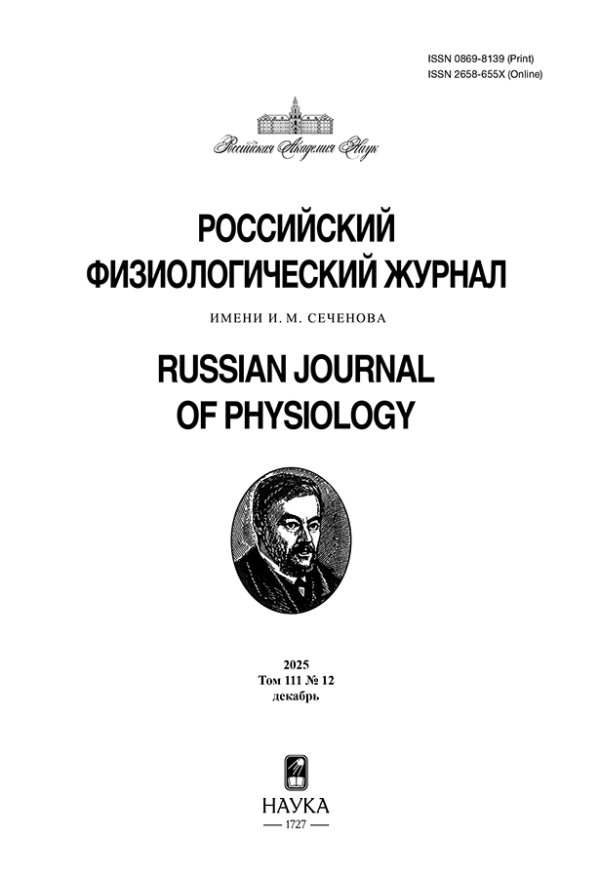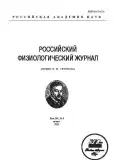Устойчивость предсердного миокарда куриного эмбриона к ингибированию HCN-каналов и компонентов системы “Cа2+-часов”
- Авторы: Лебедева Е.А.1, Гонотков М.А.1
-
Учреждения:
- Институт физиологии Коми научного центра Уральского отделения Российской академии наук
- Выпуск: Том 109, № 8 (2023)
- Страницы: 1140-1148
- Раздел: ЭКСПЕРИМЕНТАЛЬНЫЕ СТАТЬИ
- URL: https://journals.rcsi.science/0869-8139/article/view/137984
- DOI: https://doi.org/10.31857/S0869813923080071
- EDN: https://elibrary.ru/WAXHUW
- ID: 137984
Цитировать
Полный текст
Аннотация
В настоящее время клеточные основы автоматизма сердца эмбрионов, в частности вклад различных ионных механизмов, до конца не ясны и активно изучаются. С помощью микроэлектродной техники мы исследовали фармакологическую чувствительность клеток водителя ритма правого предсердия куриного эмбриона (HH36) к ивабрадину (ингибитор HCN-каналов, по которым протекает ток, активируемый гиперполяризацией (If), рианодину (агоноист рианодиновых рецепторов) и SN6 (ингибитор Na+/Ca2+-обменного механизма). Установлено, что у клеток правого предсердия, обладающих фазой медленной диастолической деполяризацией, экспозиция ивабрадина (3 мкМ) не вызывала достоверных изменений электрофизиологических параметров потенциалов действия. Рианодин (1 мкМ) и SN6 (10 мкМ) при добавлении в перфузирующий раствор вызывали сходные эффекты – повышение частоты генерации потенциалов действия в среднем на 15%. При этом не зарегистрировано нарушения автоматизма или прекращения спонтанной активности. Полученные результаты позволяют заключить, что HCN4-каналы, рианодиновые рецепторы и Na+/Ca2+-обменный механизм на данном этапе эмбрионального развития не являются определяющими для поддержания автоматизма клеток правого предсердия у куриного эмбриона. Вероятно, ионные токи, протекающие через эти каналы и играющие важную роль в электрофизиологии у взрослых животных, в эмбриональном миокарде выполняют модулирующую функцию.
Ключевые слова
Об авторах
Е. А. Лебедева
Институт физиологии Коми научного центра Уральского отделенияРоссийской академии наук
Автор, ответственный за переписку.
Email: lebedeva.physiol.komisc@ya.ru
Россия, Сыктывкар
М. А. Гонотков
Институт физиологии Коми научного центра Уральского отделенияРоссийской академии наук
Email: lebedeva.physiol.komisc@ya.ru
Россия, Сыктывкар
Список литературы
- Sedmera D, Kockova R, Vostarek F, Raddatz E (2015) Arrhythmias in the developing heart. Acta Physiol (Oxf) 213 (2):303–320.https://doi.org/10.1111/apha.12418
- Brochu RM, Clay JR, Shrier A (1992) Pacemaker current in single cells and in aggregates of cellsdissociated from the embryonic chick heart. J Physiol 454: 503–515. https://doi.org/10.1113/jphysiol.1992.sp019276
- Krogh-Madsen T, Schaffer P, Skriver AD, Taylor LK, Pelzmann B, Koidl B, Guevara MR (2005) An ionic model for rhythmic activity in small clusters of embryonic chick ventricular cells. Am J Physiol Heart Circ Physiol 289(1): 398–413. https://doi.org/10.1152/ajpheart.00683.2004
- Shepherd N, Graham V, Trevedi B, Creazzo TL (2007) Changes in regulation of sodium/calcium exchanger of avian ventricular heart cells during embryonic development. Am J Physiol Cell Physiol 292(5): 1942–1950. https://doi.org/10.1152/ajpcell.00564.2006
- Wang P, Tang M, Gao L, Luo H, Wang G, Ma X, Duan Y (2013) Roles of I(f) and intracellular Ca2+ release in spontaneous activity of ventricular cardiomyocytes during murine embryonic development. J Cell Biochem 114 (8): 1852–1862. https://doi.org/10.1002/jcb.24527
- Hescheler J, Fleischmann BK, Lentini S, Maltsev VA, Rohwedel J, Wobus AM, Addicks K (1997) Embryonic stem cells: a model to study structural and functional properties in cardiomyogenesis. Cardiovasc Res 36(2): 149–162. https://doi.org/10.1016/s0008-6363(97)00193-4
- Sartiani L, Bettiol E, Stillitano F, Mugelli A, Cerbai E, Jaconi ME (2007) Developmental changes in cardiomyocytes differentiated from human embryonic stem cells: a molecular and electrophysiological approach. Stem Cells 25(5): 1136–1144. https://doi.org/10.1634/stemcells.2006-0466
- Barbuti A, Crespi A, Capilupo D, Mazzocchi N, Baruscotti M, DiFrancesco D (2009) Molecular composition and functional properties of f-channels in murine embryonic stem cell-derived pacemaker cells. J Mol Cell Cardiol 46(3): 343–351. https://doi.org/10.1016/j.yjmcc.2008.12.001
- Opthof T (2007) Embryological development of pacemaker hierarchy and membrane currents related to the function of the adult sinus node: implications for autonomic modulation of biopacemakers. Med Biol Eng Comput 45(2): 119–132. https://doi.org/10.1007/s11517-006-0138-x.
- Goenezen S, Rennie MY, Rugonyi S (2012) Biomechanics of early cardiac development. Biomech Model Mechanobiol 11(8): 1187–1204. https://doi.org/10.1007/s10237-012-0414-7
- Polo-Parada L, Zhang X, Modgi A (2009) Cardiac cushions modulate action potential phenotype during heart development [corrected]. Dev Dyn 238(3): 611–623. https://doi.org/10.1002/dvdy.21879
- Lakatta EG, Maltsev VA, Vinogradova TM (2010) A coupled SYSTEM of intracellular Ca2+ clocks and surface membrane voltage clocks controls the timekeeping mechanism of the heart’s pacemaker. Circul Res 106(4): 659–673. https://doi.org/10.1161/CIRCRESAHA.109.206078
- DiFrancesco D, Noble D (2012) The funny current has a major pacemaking role in the sinus node. Heart Rhythm 9(2): 299–301. https://doi.org/10.1016/j.hrthm.2011.09.021
- Morotti S, Ni H, Peters CH, Rickert C, Asgari-Targhi A, Sato D, Glukhov AV, Proenza C, Grandi E (2021) Intracellular Na+ Modulates Pacemaking Activity in Murine Sinoatrial Node Myocytes: An in Silico Analysis. Int J Mol Sci 22(11): 5645. https://doi.org/10.3390/ijms22115645
- Hamburger V, Hamilton HL (1951) A series of normal stages in the development of the chick embryo. J Morphol 88(1): 49–92. https://doi.org/10.1002/jmor.1050880104
- Vicente-Steijn R, Passier R, Wisse LJ, Schalij MJ, Poelmann RE, Gittenberger-de Groot AC, Jongbloed MRM (2011) Funny current channel HCN4 delineates the developing cardiac conduction system in chicken heart. Heart Rhythm 8(8): 1254–1263. https://doi.org/10.1016/j.hrthm.2011.03.043
- Pitcairn E, Harris H, Epiney J, Pai VP, Lemire JM, Ye B, Shi NQ, Levin M, McLaughlin KA (2017) Coordinating heart morphogenesis: A novel role for hyperpolarization-activated cyclic nucleotide-gated (HCN) channels during cardiogenesis in Xenopus laevis. Commun Integr Biol 10(3): e1309488. https://doi.org/10.1080/19420889.2017.1309488
- Joung B, Tang L, Maruyama M, Han S, Chen Z, Stucky M, Jones LR, Fishbein MC, Weiss JN, Chen P-S, Lin S-F (2009) Intracellular calcium dynamics and acceleration of sinus rhythm by beta-adrenergic stimulation. Circulation 119(6): 788–796. https://doi.org/10.1161/CIRCULATIONAHA.108.817379
- Gao Z, Chen B, Joiner M-LA, Wu Y, Guan X, Koval OM, Chaudhary AK, Cunha SR, Mohler PJ, Martins JB, Song L-S, Anderson ME (2010) I(f) and SR Ca(2+) release both contribute to pacemaker activity in canine sinoatrial node cells. J Mol Cell Cardiol 49 (1): 33–40. https://doi.org/10.1016/j.yjmcc.2010.03.019
- Rigg L, Terrar DA (1996) Possible role of calcium release from the sarcoplasmic reticulum in pacemaking in guinea-pig sino-atrial node. Exp Physiol 81(5): 877–880. https://doi.org/10.1113/expphysiol.1996.sp003983
- Tóth A, Kiss L, Varró A, Nánási PP (2009) Potential therapeutic effects of Na+/Ca2+exchanger inhibition in cardiac diseases. Curr Med Chem 16(25): 3294–3321. https://doi.org/10.2174/092986709788803268
- Niu C-F, Yasuhide W, Ono K, Iwamoto T, Yamashita K, Satoh H, Urushida T, Hayashi H, Kimura J (2007) Characterization of SN-6, a novel Na+/Ca2+ exchange inhibitor in guinea pig cardiac ventricular myocytes. Eur J Pharmacol 573(1–3): 161–169. https://doi.org/10.1016/j.ejphar.2007.06.033
- Sanders L, Rakovic S, Lowe M, Mattick PAD, Terrar DA (2006) Fundamental importance of Na+-Ca2+ exchange for the pacemaking mechanism in guinea-pig sino-atrial node. J Physiol 571(3): 639–649.https://doi.org/10.1113/jphysiol.2005.100305
- Linask KK, Han MD, Artman M, Ludwig CA (2001) Sodium-calcium exchanger (NCX-1) and calcium modulation: NCX protein expression patterns and regulation of early heart development. Dev Dyn 221(3): 249–264. https://doi.org/10.1002/dvdy.1131
- Dutro SM, Airey JA, Beck CF, Sutko JL, Trumble WR (1993) Ryanodine receptor expression in embryonic avian cardiac muscle. Dev Biol 155(2): 431–441. https://doi.org/10.1006/dbio.1993.1041
Дополнительные файлы











